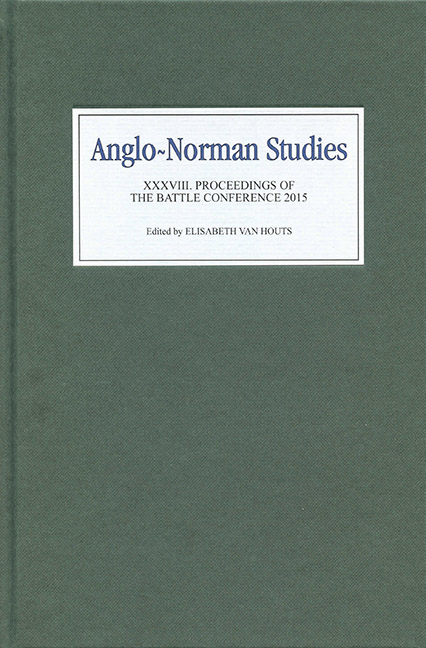Book contents
- Frontmatter
- Contents
- Illustrations and Tables
- Editor's Preface
- Abbreviations
- From the Articles of the Barons to Magna Carta (The R. Allen Brown Memorial Lecture, 2015)
- Jews in the Glosses of a Late Twelfth-Century Anglo-Norman Gratian Manuscript (Cambridge, Gonville and Caius College, MS 283/676)
- Monastic Autonomy, Episcopal Authority and the Norman Conquest: The Records of Barking Abbey (The Marjorie Chibnall Memorial Essay, 2015)
- Economy Distorted, Economy Restored: Order, Economy and Salvation in Anglo-Norman Monastic Writing
- Monastic Patronage and Family Disputes in Eleventh- and Early Twelfth-Century Normandy
- Constance, Princess of Antioch (1130–1164): Ancestry, Marriages and Family
- Early Aristocratic Seals: An Anglo-Norman Success Story
- English Towns and Urban Society after the Norman Conquest
- Wreck of the Sea in Law and Practice in Eleventh- and Twelfth-Century England
- Social Life and Religious Culture in Twelfth-Century Norwich and Norfolk
- Bad Crusaders? The Normans of Southern Italy and the Crusading Movement in the Twelfth Century
- Turold, Wadard and Vitalis: Why Are They on the Bayeux Tapestry?
Wreck of the Sea in Law and Practice in Eleventh- and Twelfth-Century England
Published online by Cambridge University Press: 12 September 2017
- Frontmatter
- Contents
- Illustrations and Tables
- Editor's Preface
- Abbreviations
- From the Articles of the Barons to Magna Carta (The R. Allen Brown Memorial Lecture, 2015)
- Jews in the Glosses of a Late Twelfth-Century Anglo-Norman Gratian Manuscript (Cambridge, Gonville and Caius College, MS 283/676)
- Monastic Autonomy, Episcopal Authority and the Norman Conquest: The Records of Barking Abbey (The Marjorie Chibnall Memorial Essay, 2015)
- Economy Distorted, Economy Restored: Order, Economy and Salvation in Anglo-Norman Monastic Writing
- Monastic Patronage and Family Disputes in Eleventh- and Early Twelfth-Century Normandy
- Constance, Princess of Antioch (1130–1164): Ancestry, Marriages and Family
- Early Aristocratic Seals: An Anglo-Norman Success Story
- English Towns and Urban Society after the Norman Conquest
- Wreck of the Sea in Law and Practice in Eleventh- and Twelfth-Century England
- Social Life and Religious Culture in Twelfth-Century Norwich and Norfolk
- Bad Crusaders? The Normans of Southern Italy and the Crusading Movement in the Twelfth Century
- Turold, Wadard and Vitalis: Why Are They on the Bayeux Tapestry?
Summary
Endeavours to find out any details about medieval shipwrecks themselves meet with very limited evidence, despite the seemingly timeless appeal of stories about them. Among the narrative sources from the Anglo-Norman period, accounts of terrors and disasters at sea abound, the wreck of the White Ship in 1120 being one of the most infamous. However, no wreckages of whole ships have yet been excavated in England or Normandy that date from the twelfth century. The nature of the evidence also makes it impossible to know how many, or with what frequency, shipwrecks actually occurred. In this article I will instead detail the evidence for what happened in medieval England when a wrecked ship and its cargo washed onto land. I will investigate not the open sea but the foreshore, the coastal zone between high and low tide. This is a physical space defined by the variables of coastline, tide, weather and wave. It is also a jurisdictional space, considered in Roman law to be ‘naturally everybody's’. In the Middle Ages, various groups had some claim to, or desire for, recognition of their liberties there; sailors, merchants, ship owners, coastal dwellers, coastal landlords and the king all had interests in the right to exploit wrecked ships and their cargo. How these interests were negotiated, as seen through an examination of the legal record, may tell us about the society in which these shipwrecks occurred.
If this all seems peripheral to Anglo-Norman studies, coastlines were certainly not peripheral to the Anglo-Norman realm; rather, they were important zones within its travel and trade networks. After the Norman Conquest of England in 1066, cross- Channel voyages became more common, especially for the nobility and their agents. This was also an active age of shipping for fishing and trade, with new port towns founded and existing ones expanded over the eleventh and twelfth centuries. Shipwrights were constructing larger vessels, with cargo ships in northern Europe exhibiting a fivefold increase in carrying capacity between about the years 1000 and 1250.
- Type
- Chapter
- Information
- Anglo-Norman Studies XXXVIIIProceedings of the Battle Conference 2015, pp. 141 - 154Publisher: Boydell & BrewerPrint publication year: 2016



